Comprehensive Benefit Plan Evaluation for Tertiary Sector Employees
VerifiedAdded on 2021/06/16
|10
|2676
|60
Report
AI Summary
This report examines the factors influencing benefit plans for tertiary sector employees, focusing on superannuation, defined benefit plans (DBP), and investment continuance plans (ICP). The DBP is analyzed considering factors such as age, time to retirement, and salary, with examples of how these factors affect the final benefit. The report also details the ICP, including its components: trust fund, secure fund, stable fund, and shares fund, highlighting their roles in retirement benefits and risk management. The time value of money (TVM) is discussed in the context of financial decision-making, emphasizing its importance in projecting financial expectations and managing cash flow for investment decisions. The study underscores the significance of these plans for employees' financial security during retirement and the need for careful consideration of various factors when making superannuation contributions. This report provides a comprehensive overview of the critical elements involved in structuring and evaluating benefit plans within the tertiary sector, including the importance of secure and stable funds, trustee responsibilities, and the role of shares funds in retirement planning.
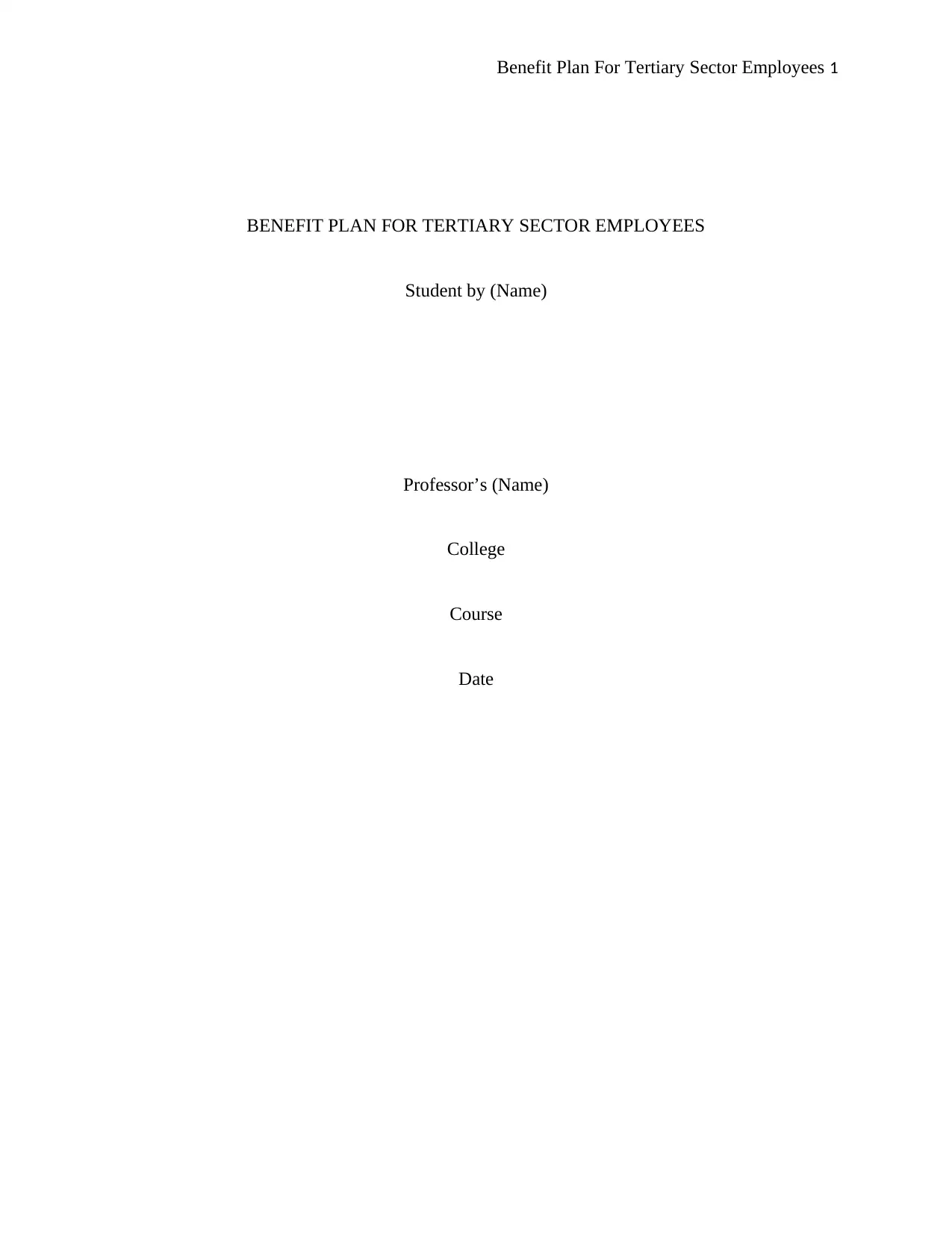
Benefit Plan For Tertiary Sector Employees 1
BENEFIT PLAN FOR TERTIARY SECTOR EMPLOYEES
Student by (Name)
Professor’s (Name)
College
Course
Date
BENEFIT PLAN FOR TERTIARY SECTOR EMPLOYEES
Student by (Name)
Professor’s (Name)
College
Course
Date
Paraphrase This Document
Need a fresh take? Get an instant paraphrase of this document with our AI Paraphraser
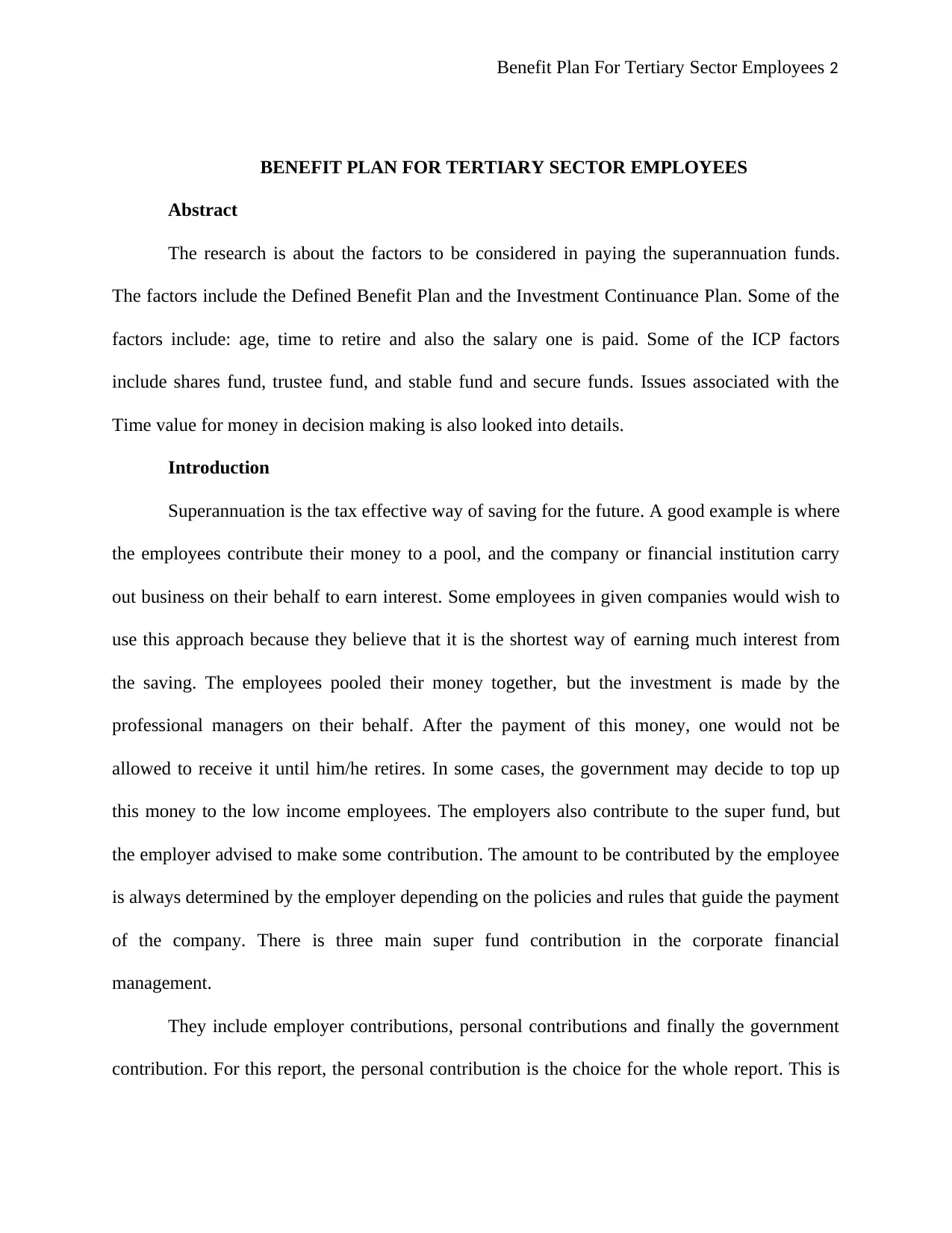
Benefit Plan For Tertiary Sector Employees 2
BENEFIT PLAN FOR TERTIARY SECTOR EMPLOYEES
Abstract
The research is about the factors to be considered in paying the superannuation funds.
The factors include the Defined Benefit Plan and the Investment Continuance Plan. Some of the
factors include: age, time to retire and also the salary one is paid. Some of the ICP factors
include shares fund, trustee fund, and stable fund and secure funds. Issues associated with the
Time value for money in decision making is also looked into details.
Introduction
Superannuation is the tax effective way of saving for the future. A good example is where
the employees contribute their money to a pool, and the company or financial institution carry
out business on their behalf to earn interest. Some employees in given companies would wish to
use this approach because they believe that it is the shortest way of earning much interest from
the saving. The employees pooled their money together, but the investment is made by the
professional managers on their behalf. After the payment of this money, one would not be
allowed to receive it until him/he retires. In some cases, the government may decide to top up
this money to the low income employees. The employers also contribute to the super fund, but
the employer advised to make some contribution. The amount to be contributed by the employee
is always determined by the employer depending on the policies and rules that guide the payment
of the company. There is three main super fund contribution in the corporate financial
management.
They include employer contributions, personal contributions and finally the government
contribution. For this report, the personal contribution is the choice for the whole report. This is
BENEFIT PLAN FOR TERTIARY SECTOR EMPLOYEES
Abstract
The research is about the factors to be considered in paying the superannuation funds.
The factors include the Defined Benefit Plan and the Investment Continuance Plan. Some of the
factors include: age, time to retire and also the salary one is paid. Some of the ICP factors
include shares fund, trustee fund, and stable fund and secure funds. Issues associated with the
Time value for money in decision making is also looked into details.
Introduction
Superannuation is the tax effective way of saving for the future. A good example is where
the employees contribute their money to a pool, and the company or financial institution carry
out business on their behalf to earn interest. Some employees in given companies would wish to
use this approach because they believe that it is the shortest way of earning much interest from
the saving. The employees pooled their money together, but the investment is made by the
professional managers on their behalf. After the payment of this money, one would not be
allowed to receive it until him/he retires. In some cases, the government may decide to top up
this money to the low income employees. The employers also contribute to the super fund, but
the employer advised to make some contribution. The amount to be contributed by the employee
is always determined by the employer depending on the policies and rules that guide the payment
of the company. There is three main super fund contribution in the corporate financial
management.
They include employer contributions, personal contributions and finally the government
contribution. For this report, the personal contribution is the choice for the whole report. This is

Benefit Plan For Tertiary Sector Employees 3
where the employees are expected to make a pool payment which will be later used by the
managers to carry out business on behalf of their employees. For the self-employed people, they
are required to make their contribution to the super fund (Ingles 2009). The following are some
of the ways one can use to make due to the super fund: salary sacrificing, the personal input from
the pay, the bank transfers to the super fund and finally the super transfer to the super main
account. Retired benefits are very significancant for any employed person. Everyone believes
that after attaining the retirement age he/she should be taking something home as a benefit for
hard work. For this reason, the superannuation is considered to be very useful to the life of the
retired employees.
Important factors that should be considered by the Benefit Plan for tertiary sector
employees while deciding to place superannuation contributions in the defined benefit plan.
Some of the factors to be considered include the following:
Defined Benefit Plan-This the pension benefits plan where the employee is assigned the
periods of his service depending on the pension benefit formulae that have been used. This one
of the critical factors that should be considered in payment of the superannuation. For example,
if an employee has worked for 40 years and has earned a total salary of $ 50000. Then the
defined benefit plan becomes 1%×40×50000=2000 (Social Security Administration 2013). The
formulae are very crucial for the calculations related to the super funds. In the Defined Benefit
Plan, the assigning of the payment depends on the period that has been appointed by the
employer by the benefits plan formula. For example, if the employee has worked for 40 years
and the total salary is $50000 and has worked for 40years, this implies that the full payment to be
made is $2000. The Defined Benefit Plan is also affected by some of the attributes of the
where the employees are expected to make a pool payment which will be later used by the
managers to carry out business on behalf of their employees. For the self-employed people, they
are required to make their contribution to the super fund (Ingles 2009). The following are some
of the ways one can use to make due to the super fund: salary sacrificing, the personal input from
the pay, the bank transfers to the super fund and finally the super transfer to the super main
account. Retired benefits are very significancant for any employed person. Everyone believes
that after attaining the retirement age he/she should be taking something home as a benefit for
hard work. For this reason, the superannuation is considered to be very useful to the life of the
retired employees.
Important factors that should be considered by the Benefit Plan for tertiary sector
employees while deciding to place superannuation contributions in the defined benefit plan.
Some of the factors to be considered include the following:
Defined Benefit Plan-This the pension benefits plan where the employee is assigned the
periods of his service depending on the pension benefit formulae that have been used. This one
of the critical factors that should be considered in payment of the superannuation. For example,
if an employee has worked for 40 years and has earned a total salary of $ 50000. Then the
defined benefit plan becomes 1%×40×50000=2000 (Social Security Administration 2013). The
formulae are very crucial for the calculations related to the super funds. In the Defined Benefit
Plan, the assigning of the payment depends on the period that has been appointed by the
employer by the benefits plan formula. For example, if the employee has worked for 40 years
and the total salary is $50000 and has worked for 40years, this implies that the full payment to be
made is $2000. The Defined Benefit Plan is also affected by some of the attributes of the
⊘ This is a preview!⊘
Do you want full access?
Subscribe today to unlock all pages.

Trusted by 1+ million students worldwide
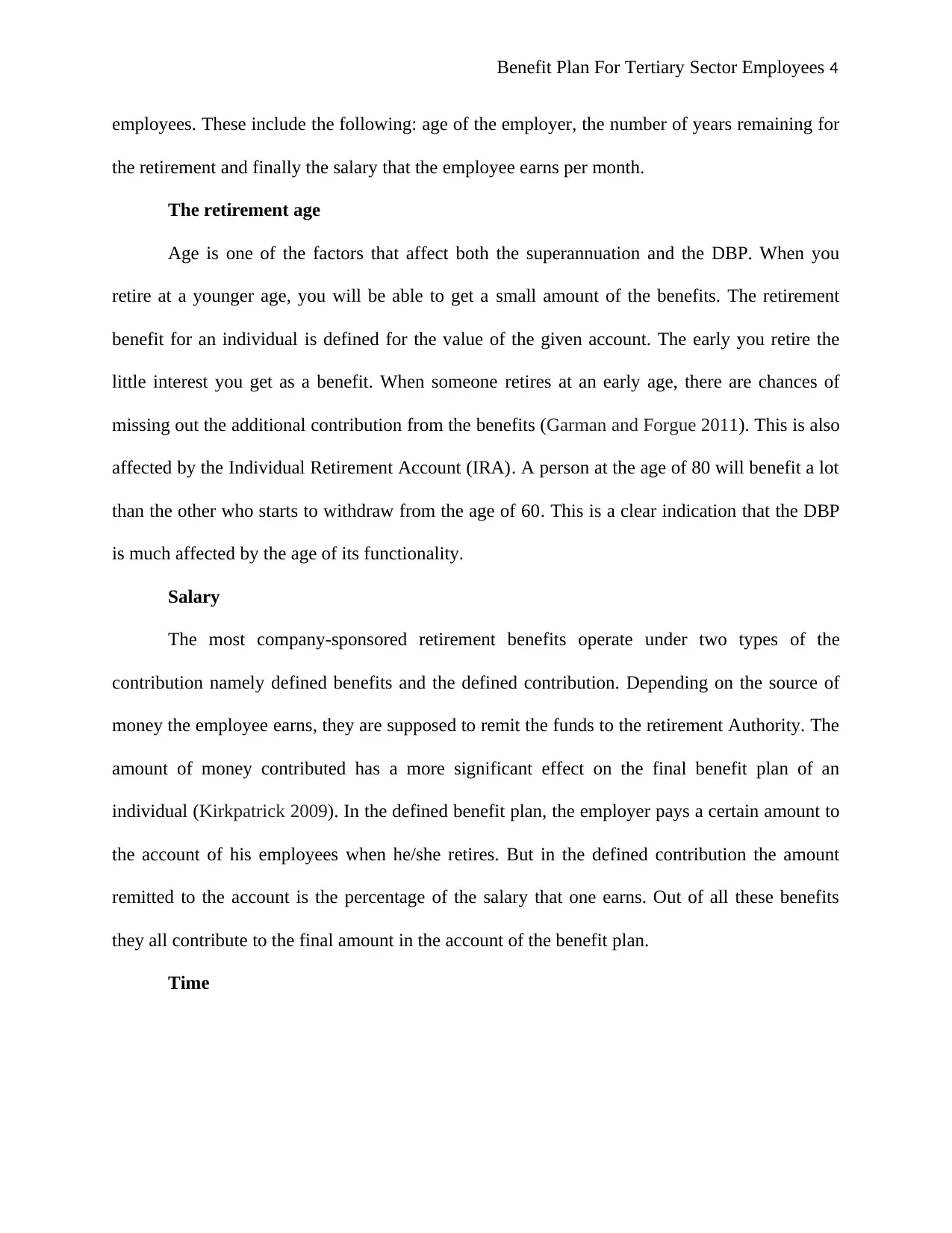
Benefit Plan For Tertiary Sector Employees 4
employees. These include the following: age of the employer, the number of years remaining for
the retirement and finally the salary that the employee earns per month.
The retirement age
Age is one of the factors that affect both the superannuation and the DBP. When you
retire at a younger age, you will be able to get a small amount of the benefits. The retirement
benefit for an individual is defined for the value of the given account. The early you retire the
little interest you get as a benefit. When someone retires at an early age, there are chances of
missing out the additional contribution from the benefits (Garman and Forgue 2011). This is also
affected by the Individual Retirement Account (IRA). A person at the age of 80 will benefit a lot
than the other who starts to withdraw from the age of 60. This is a clear indication that the DBP
is much affected by the age of its functionality.
Salary
The most company-sponsored retirement benefits operate under two types of the
contribution namely defined benefits and the defined contribution. Depending on the source of
money the employee earns, they are supposed to remit the funds to the retirement Authority. The
amount of money contributed has a more significant effect on the final benefit plan of an
individual (Kirkpatrick 2009). In the defined benefit plan, the employer pays a certain amount to
the account of his employees when he/she retires. But in the defined contribution the amount
remitted to the account is the percentage of the salary that one earns. Out of all these benefits
they all contribute to the final amount in the account of the benefit plan.
Time
employees. These include the following: age of the employer, the number of years remaining for
the retirement and finally the salary that the employee earns per month.
The retirement age
Age is one of the factors that affect both the superannuation and the DBP. When you
retire at a younger age, you will be able to get a small amount of the benefits. The retirement
benefit for an individual is defined for the value of the given account. The early you retire the
little interest you get as a benefit. When someone retires at an early age, there are chances of
missing out the additional contribution from the benefits (Garman and Forgue 2011). This is also
affected by the Individual Retirement Account (IRA). A person at the age of 80 will benefit a lot
than the other who starts to withdraw from the age of 60. This is a clear indication that the DBP
is much affected by the age of its functionality.
Salary
The most company-sponsored retirement benefits operate under two types of the
contribution namely defined benefits and the defined contribution. Depending on the source of
money the employee earns, they are supposed to remit the funds to the retirement Authority. The
amount of money contributed has a more significant effect on the final benefit plan of an
individual (Kirkpatrick 2009). In the defined benefit plan, the employer pays a certain amount to
the account of his employees when he/she retires. But in the defined contribution the amount
remitted to the account is the percentage of the salary that one earns. Out of all these benefits
they all contribute to the final amount in the account of the benefit plan.
Time
Paraphrase This Document
Need a fresh take? Get an instant paraphrase of this document with our AI Paraphraser
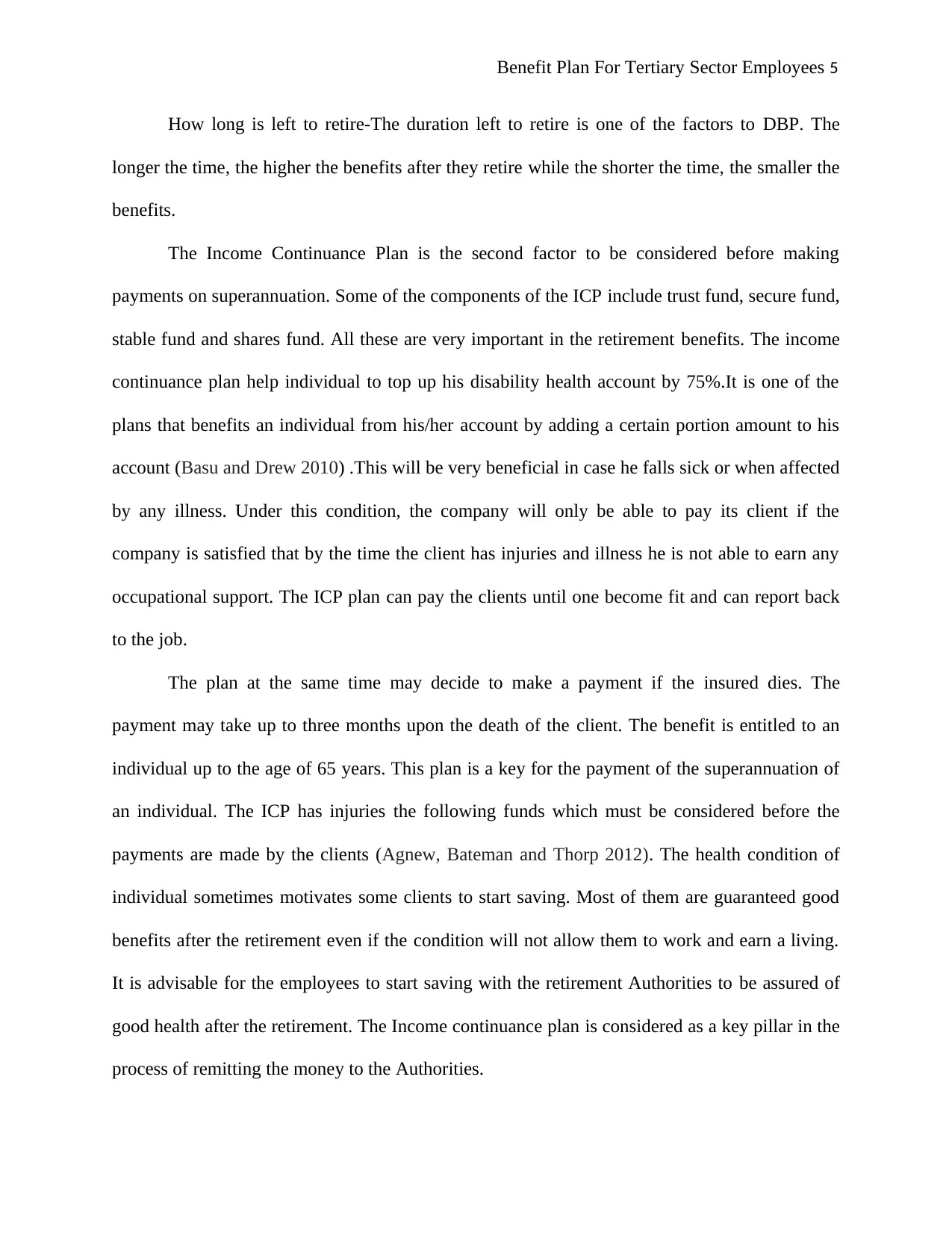
Benefit Plan For Tertiary Sector Employees 5
How long is left to retire-The duration left to retire is one of the factors to DBP. The
longer the time, the higher the benefits after they retire while the shorter the time, the smaller the
benefits.
The Income Continuance Plan is the second factor to be considered before making
payments on superannuation. Some of the components of the ICP include trust fund, secure fund,
stable fund and shares fund. All these are very important in the retirement benefits. The income
continuance plan help individual to top up his disability health account by 75%.It is one of the
plans that benefits an individual from his/her account by adding a certain portion amount to his
account (Basu and Drew 2010) .This will be very beneficial in case he falls sick or when affected
by any illness. Under this condition, the company will only be able to pay its client if the
company is satisfied that by the time the client has injuries and illness he is not able to earn any
occupational support. The ICP plan can pay the clients until one become fit and can report back
to the job.
The plan at the same time may decide to make a payment if the insured dies. The
payment may take up to three months upon the death of the client. The benefit is entitled to an
individual up to the age of 65 years. This plan is a key for the payment of the superannuation of
an individual. The ICP has injuries the following funds which must be considered before the
payments are made by the clients (Agnew, Bateman and Thorp 2012). The health condition of
individual sometimes motivates some clients to start saving. Most of them are guaranteed good
benefits after the retirement even if the condition will not allow them to work and earn a living.
It is advisable for the employees to start saving with the retirement Authorities to be assured of
good health after the retirement. The Income continuance plan is considered as a key pillar in the
process of remitting the money to the Authorities.
How long is left to retire-The duration left to retire is one of the factors to DBP. The
longer the time, the higher the benefits after they retire while the shorter the time, the smaller the
benefits.
The Income Continuance Plan is the second factor to be considered before making
payments on superannuation. Some of the components of the ICP include trust fund, secure fund,
stable fund and shares fund. All these are very important in the retirement benefits. The income
continuance plan help individual to top up his disability health account by 75%.It is one of the
plans that benefits an individual from his/her account by adding a certain portion amount to his
account (Basu and Drew 2010) .This will be very beneficial in case he falls sick or when affected
by any illness. Under this condition, the company will only be able to pay its client if the
company is satisfied that by the time the client has injuries and illness he is not able to earn any
occupational support. The ICP plan can pay the clients until one become fit and can report back
to the job.
The plan at the same time may decide to make a payment if the insured dies. The
payment may take up to three months upon the death of the client. The benefit is entitled to an
individual up to the age of 65 years. This plan is a key for the payment of the superannuation of
an individual. The ICP has injuries the following funds which must be considered before the
payments are made by the clients (Agnew, Bateman and Thorp 2012). The health condition of
individual sometimes motivates some clients to start saving. Most of them are guaranteed good
benefits after the retirement even if the condition will not allow them to work and earn a living.
It is advisable for the employees to start saving with the retirement Authorities to be assured of
good health after the retirement. The Income continuance plan is considered as a key pillar in the
process of remitting the money to the Authorities.
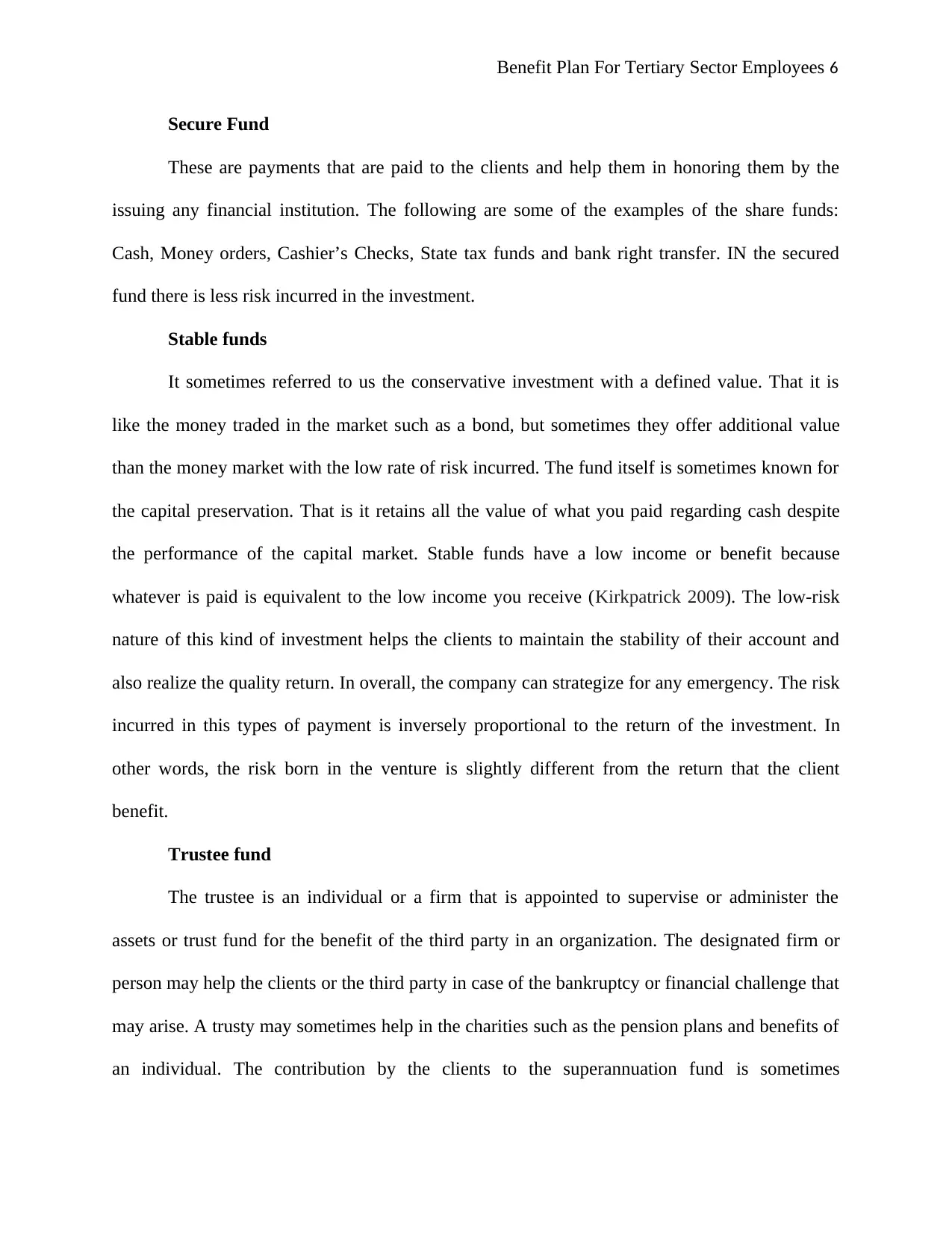
Benefit Plan For Tertiary Sector Employees 6
Secure Fund
These are payments that are paid to the clients and help them in honoring them by the
issuing any financial institution. The following are some of the examples of the share funds:
Cash, Money orders, Cashier’s Checks, State tax funds and bank right transfer. IN the secured
fund there is less risk incurred in the investment.
Stable funds
It sometimes referred to us the conservative investment with a defined value. That it is
like the money traded in the market such as a bond, but sometimes they offer additional value
than the money market with the low rate of risk incurred. The fund itself is sometimes known for
the capital preservation. That is it retains all the value of what you paid regarding cash despite
the performance of the capital market. Stable funds have a low income or benefit because
whatever is paid is equivalent to the low income you receive (Kirkpatrick 2009). The low-risk
nature of this kind of investment helps the clients to maintain the stability of their account and
also realize the quality return. In overall, the company can strategize for any emergency. The risk
incurred in this types of payment is inversely proportional to the return of the investment. In
other words, the risk born in the venture is slightly different from the return that the client
benefit.
Trustee fund
The trustee is an individual or a firm that is appointed to supervise or administer the
assets or trust fund for the benefit of the third party in an organization. The designated firm or
person may help the clients or the third party in case of the bankruptcy or financial challenge that
may arise. A trusty may sometimes help in the charities such as the pension plans and benefits of
an individual. The contribution by the clients to the superannuation fund is sometimes
Secure Fund
These are payments that are paid to the clients and help them in honoring them by the
issuing any financial institution. The following are some of the examples of the share funds:
Cash, Money orders, Cashier’s Checks, State tax funds and bank right transfer. IN the secured
fund there is less risk incurred in the investment.
Stable funds
It sometimes referred to us the conservative investment with a defined value. That it is
like the money traded in the market such as a bond, but sometimes they offer additional value
than the money market with the low rate of risk incurred. The fund itself is sometimes known for
the capital preservation. That is it retains all the value of what you paid regarding cash despite
the performance of the capital market. Stable funds have a low income or benefit because
whatever is paid is equivalent to the low income you receive (Kirkpatrick 2009). The low-risk
nature of this kind of investment helps the clients to maintain the stability of their account and
also realize the quality return. In overall, the company can strategize for any emergency. The risk
incurred in this types of payment is inversely proportional to the return of the investment. In
other words, the risk born in the venture is slightly different from the return that the client
benefit.
Trustee fund
The trustee is an individual or a firm that is appointed to supervise or administer the
assets or trust fund for the benefit of the third party in an organization. The designated firm or
person may help the clients or the third party in case of the bankruptcy or financial challenge that
may arise. A trusty may sometimes help in the charities such as the pension plans and benefits of
an individual. The contribution by the clients to the superannuation fund is sometimes
⊘ This is a preview!⊘
Do you want full access?
Subscribe today to unlock all pages.

Trusted by 1+ million students worldwide

Benefit Plan For Tertiary Sector Employees 7
determined by the decisions made by the trustees to the retirement benefit fund ((Agnew,
Bateman and Thorp 2012). The trustees in the trust fund are given the mandate to make the
decisions which are beneficial to the clients regarding the retirement benefits. The trust fund, the
beneficiary can know the nature of the assets or titles deeds that may be required by the concern
Authority before the payments are made by the third party (the beneficiaries of the retirement
benefits). Trustee fund is sometimes characterized by the given risk and the return. For example,
a client may decide to offer an asset such as the title deeds to the trustee, but in return fail to
benefit from the same due to the mismanagement by the assigned trustees. This, therefore, calls
for full collaboration between the beneficiaries and the trustees.
Shares fund is also considered to be part of the ICP in the retirement benefit. The shares
fund is the mutual funds that are given to the clients by the company. This is done after a period
of investment or contribution to the company kitty. Shares fund is very crucial for any company.
For example in the retirement benefit companies, the money or the shares received by an
individual depend on the amount of investment one has been remitting for the period This
becomes one of the factors that we considered before contributing to the retirement benefit
Authorities (Agnew, Bateman and Thorp 2012). The more you add to the financial pool of a
company the more shares you receive as a return.
The relationship between the time value of the money and the decision-making
process
The time money value condition refers to the reality that is imposed on money for
example under normal state, the value of money will still have more value despite the inflation
experienced in the future. Time money value is very instrumental in the management of the
organizations and companies. There are some things that pop up as a result of this
determined by the decisions made by the trustees to the retirement benefit fund ((Agnew,
Bateman and Thorp 2012). The trustees in the trust fund are given the mandate to make the
decisions which are beneficial to the clients regarding the retirement benefits. The trust fund, the
beneficiary can know the nature of the assets or titles deeds that may be required by the concern
Authority before the payments are made by the third party (the beneficiaries of the retirement
benefits). Trustee fund is sometimes characterized by the given risk and the return. For example,
a client may decide to offer an asset such as the title deeds to the trustee, but in return fail to
benefit from the same due to the mismanagement by the assigned trustees. This, therefore, calls
for full collaboration between the beneficiaries and the trustees.
Shares fund is also considered to be part of the ICP in the retirement benefit. The shares
fund is the mutual funds that are given to the clients by the company. This is done after a period
of investment or contribution to the company kitty. Shares fund is very crucial for any company.
For example in the retirement benefit companies, the money or the shares received by an
individual depend on the amount of investment one has been remitting for the period This
becomes one of the factors that we considered before contributing to the retirement benefit
Authorities (Agnew, Bateman and Thorp 2012). The more you add to the financial pool of a
company the more shares you receive as a return.
The relationship between the time value of the money and the decision-making
process
The time money value condition refers to the reality that is imposed on money for
example under normal state, the value of money will still have more value despite the inflation
experienced in the future. Time money value is very instrumental in the management of the
organizations and companies. There are some things that pop up as a result of this
Paraphrase This Document
Need a fresh take? Get an instant paraphrase of this document with our AI Paraphraser

Benefit Plan For Tertiary Sector Employees 8
conditions .sometimes the TVM is very important for example the money at hand today may be
of higher value shortly. The time value for money provides a projection the financial expectation
of a company soon. For this case, the financial institution can budget and prepare for the
expected changes. The financial managers can have a clear picture of the expectations regarding
the capital investment (Booth and Wood 2008). By using the cash flow, the monetary Authorities
can use it to determine the cash flow back any potential risk that is associated with the venture.
This in return help in the investment decision making of a company. The Time Value Money is
also helpful in making the financial decision on the daily activities. The tool can also be used in
evaluating the company's option in paying and receiving of Money (Booth and Wood 2008). The
Company may also use the Time Value Money in determining the amount of money to give the
customers as a return benefit. Lastly, since the tool is a projection of the future in terms of
financial value, the company can budget on the type of things to buy in relation to their prices.
Conclusion
By considering the above factors in the superannuation, the clients will be able to make
payments without any difficulty. The Defined Benefit Plan and the investment Continuance
factors are very important considerations in the amount of the retiree benefits. Finally, the Time
Value and Money is the best tool for decision making in an investment organization.
conditions .sometimes the TVM is very important for example the money at hand today may be
of higher value shortly. The time value for money provides a projection the financial expectation
of a company soon. For this case, the financial institution can budget and prepare for the
expected changes. The financial managers can have a clear picture of the expectations regarding
the capital investment (Booth and Wood 2008). By using the cash flow, the monetary Authorities
can use it to determine the cash flow back any potential risk that is associated with the venture.
This in return help in the investment decision making of a company. The Time Value Money is
also helpful in making the financial decision on the daily activities. The tool can also be used in
evaluating the company's option in paying and receiving of Money (Booth and Wood 2008). The
Company may also use the Time Value Money in determining the amount of money to give the
customers as a return benefit. Lastly, since the tool is a projection of the future in terms of
financial value, the company can budget on the type of things to buy in relation to their prices.
Conclusion
By considering the above factors in the superannuation, the clients will be able to make
payments without any difficulty. The Defined Benefit Plan and the investment Continuance
factors are very important considerations in the amount of the retiree benefits. Finally, the Time
Value and Money is the best tool for decision making in an investment organization.

Benefit Plan For Tertiary Sector Employees 9
References
Agnew, J., 2013. Australia’s retirement system: Strengths, weaknesses, and reforms. Center for
Retirement Research Issue Brief, pp.13-5.
Agnew, J., Bateman, H. and Thorp, S., 2012. Financial Literacy and Retirement Planning in
Australian. 3(2), pp.300-310
Agnew, J., Bateman, H. and Thorp, S., 2012. Superannuation knowledge and plan behavior. 3(4),
pp.345-360
Basu, A.K. and Drew, M.E., 2010. The appropriateness of default investment options in defined
contribution plans: Australian evidence. Pacific-Basin Finance Journal, 18(3), pp.290-305.
Bateman, H., 2015. Structuring the payout phase in a defined contribution scheme in high
income countries: Experiences of Australia and New Zealand. In Strengthening Social Protection
in East Asia (pp. 91-123). Routledge.
Booth, A.L. and Wood, M., 2008. Back‐to‐Front Down Under? Part‐Time/Full‐Time Wage
Differentials in Australia. Industrial Relations: A Journal of economy and society, 47(1), pp.114-
135.
Garman, E.T. and Forgue, R., 2011. Personal finance. Cengage Learning.
References
Agnew, J., 2013. Australia’s retirement system: Strengths, weaknesses, and reforms. Center for
Retirement Research Issue Brief, pp.13-5.
Agnew, J., Bateman, H. and Thorp, S., 2012. Financial Literacy and Retirement Planning in
Australian. 3(2), pp.300-310
Agnew, J., Bateman, H. and Thorp, S., 2012. Superannuation knowledge and plan behavior. 3(4),
pp.345-360
Basu, A.K. and Drew, M.E., 2010. The appropriateness of default investment options in defined
contribution plans: Australian evidence. Pacific-Basin Finance Journal, 18(3), pp.290-305.
Bateman, H., 2015. Structuring the payout phase in a defined contribution scheme in high
income countries: Experiences of Australia and New Zealand. In Strengthening Social Protection
in East Asia (pp. 91-123). Routledge.
Booth, A.L. and Wood, M., 2008. Back‐to‐Front Down Under? Part‐Time/Full‐Time Wage
Differentials in Australia. Industrial Relations: A Journal of economy and society, 47(1), pp.114-
135.
Garman, E.T. and Forgue, R., 2011. Personal finance. Cengage Learning.
⊘ This is a preview!⊘
Do you want full access?
Subscribe today to unlock all pages.

Trusted by 1+ million students worldwide
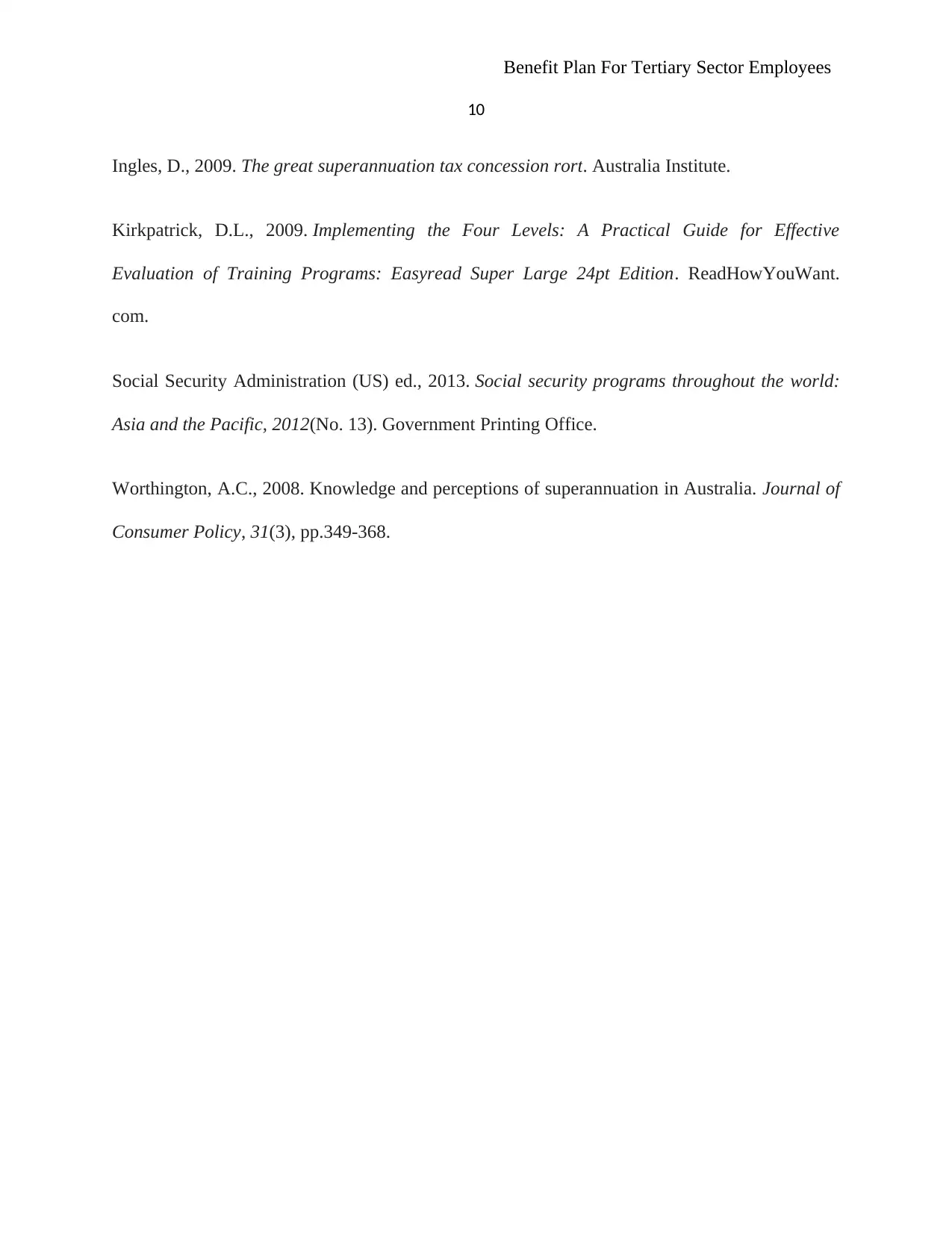
Benefit Plan For Tertiary Sector Employees
10
Ingles, D., 2009. The great superannuation tax concession rort. Australia Institute.
Kirkpatrick, D.L., 2009. Implementing the Four Levels: A Practical Guide for Effective
Evaluation of Training Programs: Easyread Super Large 24pt Edition. ReadHowYouWant.
com.
Social Security Administration (US) ed., 2013. Social security programs throughout the world:
Asia and the Pacific, 2012(No. 13). Government Printing Office.
Worthington, A.C., 2008. Knowledge and perceptions of superannuation in Australia. Journal of
Consumer Policy, 31(3), pp.349-368.
10
Ingles, D., 2009. The great superannuation tax concession rort. Australia Institute.
Kirkpatrick, D.L., 2009. Implementing the Four Levels: A Practical Guide for Effective
Evaluation of Training Programs: Easyread Super Large 24pt Edition. ReadHowYouWant.
com.
Social Security Administration (US) ed., 2013. Social security programs throughout the world:
Asia and the Pacific, 2012(No. 13). Government Printing Office.
Worthington, A.C., 2008. Knowledge and perceptions of superannuation in Australia. Journal of
Consumer Policy, 31(3), pp.349-368.
1 out of 10
Related Documents
Your All-in-One AI-Powered Toolkit for Academic Success.
+13062052269
info@desklib.com
Available 24*7 on WhatsApp / Email
![[object Object]](/_next/static/media/star-bottom.7253800d.svg)
Unlock your academic potential
Copyright © 2020–2025 A2Z Services. All Rights Reserved. Developed and managed by ZUCOL.




